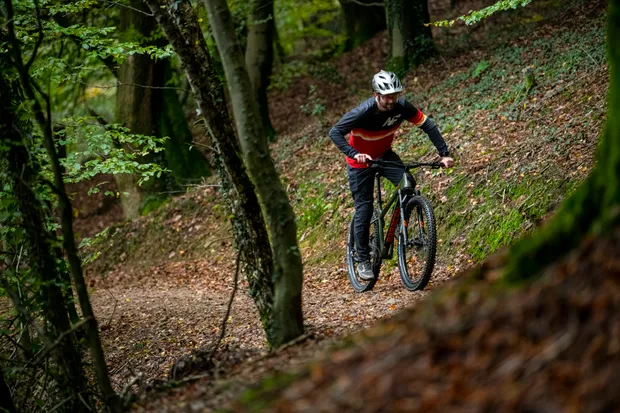Every new mountain biker may not have their bike dialed in perfectly the first time they hop on it. However, there are common setup errors that even experienced riders sometimes make.
Although bike setup is highly individualized, there are certain mistakes that tend to recur during our rides, causing us a bit of distress.
Spending some time to consider your bike’s setup can significantly enhance its performance and your comfort while riding.
Take a glance at the following list and start tinkering. Who knows, you might discover your ideal setup.
Table of Contents
1. Brake lever levels
When tackling steep or challenging terrain, making adjustments to the angle of your brake levers can significantly improve control and comfort.
It’s quite common to spot brake levers angled excessively downward, almost pointing towards the fork crown.
This positioning forces your wrists to bend over the handlebars when reaching for the lever, causing your body weight to shift forward. Moreover, if you encounter an unexpected bump, your wrist is more likely to roll further forward.
By setting the levers in a flatter position, you can rotate your wrists behind the bars, enabling you to maneuver the bike over obstacles with greater ease and providing added stability when encountering rough terrain. It is recommended not to exceed a 40-degree angle from horizontal, with the optimal range typically falling between 20 to 30 degrees.
Pairing this adjustment with a brake bite point closer to the bars can help reduce arm fatigue during rides.
2. Set your suspension right
Understanding suspension settings can be a bit perplexing, as there are various knobs to adjust and air pressures to fine-tune. However, mastering these adjustments can completely alter a bike’s performance and enhance your speed on the trails.
For riders with full-suspension bikes, achieving proper synchronization between the fork and shock is crucial. It is essential that both the fork and shock respond similarly to impacts; an imbalance where the fork bottoms out while the shock barely moves can affect the overall performance of your suspension system.
Similarly, damping plays a vital role in suspension performance. Excessive damping (utilizing high levels of compression and rebound damping) can make the suspension feel sluggish and unresponsive, whereas insufficient damping can result in a bouncy, pogo-stick-like ride experience.
3. Saddle sores
Proper saddle positioning is essential for ensuring comfort, regardless of gender, and can help prevent saddle-related issues like sores.
A saddle tilted upwards at the nose is more likely to lead to discomfort. Therefore, we recommend slightly angling it downwards for a more comfortable ride.
Furthermore, for the majority of riders, we advise against pushing the saddle all the way back on the seatpost. This adjustment can slacken the seat angle, potentially placing your hips in a suboptimal pedaling position and shifting your weight towards the rear wheel, which is not ideal for steep climbs.
If your saddle is pushed all the way back on a lay-back seatpost, it may indicate that your bike is too small for you. While individual factors can sometimes justify this setup, it is generally advisable to avoid extreme adjustments like this.
4. Tyre trouble
Similar to suspension setup, finding the optimal tire pressure for your mountain bike requires some investigation and trial and error.
The correct tire pressure for your bike is influenced by factors such as the combination of your rim and tire, your weight and riding style, the construction of the tire, and whether you are using a tubeless setup. With numerous variables to take into account, it’s safe to say that finding the perfect tire pressure may require some experimentation, as no rider typically gets it right on the first attempt.
5. Your cleats are too far forward
It is a common tendency among riders to position clipless pedal cleats excessively forward on their shoes. The reason behind this behavior remains uncertain, but it is seldom the optimal choice for riders.
As with any aspect of biking, there is no definitive rule for installing and adjusting cleats. It is advisable to begin with a neutral position and make adjustments accordingly.
Typically, shifting your cleats towards the rear is more likely to enhance control and minimize fatigue on a mountain bike compared to positioning them forward. This adjustment is beneficial because when encountering bumps or landing jumps, your foot, ankle, and leg muscles must counter the pedal’s backward rotation. Placing the cleats further forward increases the lever length and intensifies the effort required to prevent the pedal from rotating. Conversely, moving the cleats backward reduces the exertion needed to halt the pedal’s rotation.
It is common to observe flat pedal mountain bike riders, who have the freedom to position their feet anywhere on the pedals, naturally adopting a rearward cleat position for this reason.
Furthermore, relocating the cleats towards the mid-foot can distribute pedaling forces more evenly across the entire foot, mitigating discomfort.
- Mastering the Art of Solo Cycling: 10 Essential Tips for Success - February 28, 2024
- Core Training for Cyclists : Transform Your Ride - February 27, 2024
- 10 Ways to Enhance Your Breathing for Better Cycling Performance - February 26, 2024

